|
Tule
Ponds at Tyson
ARTHROPODS |
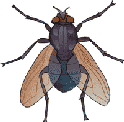 |
|
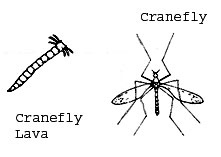 ORDER
DIPTERA ORDER
DIPTERA
These are one of the largest group of flies. The larvae tend to be
oblong, cylindrical and somewhat tapered toward the head. The head
is retractable and only partially hardened. |
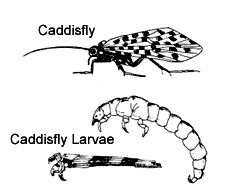 Order
Trichoptera Order
Trichoptera
All caddisflies
have hard-shelled head capsules. Sometimes the first three segments
behind the head also have hard-shelled plates on the top surface
above the attachments for three pair of legs. The rest of the body
is soft and often cylindrical. The larvae possess two small hooks
on the last segment. Some species are free-living while others make
case retreats out of silk, sand grains, pebbles, or bits of plant
material.
Caddisflies undergo complete metamorphosis and the larvae transform
into winged adults in the water. As adults, caddisflies only live a
few days and do not eat at all.several finger-like lobes. |
|
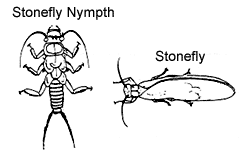 Order
Plecoptera Order
Plecoptera
Stoneflies are indicators of good water
quality because the nymphs require highly oxygenated water. They
tend to inhabit clear cold streams, and are highly intolerant of
changes in water quality.
Stoneflies undergo incomplete metamorphosis.
The aquatic nymphs transform directly into winged adults. The heads
and top surface of the first three body segments on nymphs are
hardened. Their antennae are moderately long to long, and all
species have exactly two tail filaments.
Stonefly nymphs have gills
around the base of their legs or no gills at all. |
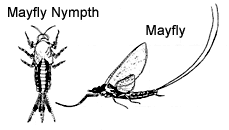 Order
Ephemeroptera Order
Ephemeroptera
Mayflies are usually easy to identify. The
nymphs can be small and squat, or long and slender. They have three
pairs of segmented legs and visible antennae. They are most easily
identified by their three tail filaments (although they may have 2),
and by the seven pairs of abdominal gills found on most species.
The gills may be either flat and spade shaped, or feathery in
appearance.
Mayfly nymphs are often
flattened or streamlined to reduce the force of fast currents. They
are most abundant in clear streams, though a few kinds may be found
in other habitats. |
|
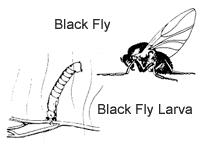  Order
Diptera Order
Diptera
True flies lack jointed
legs. Some have complete, exposed head capsules; others have a
reduced retracted head. The bodies are soft and flexible. |
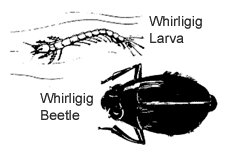 Order
Coleoptera Order
Coleoptera
Largest order of insects
representing about 40% of known insect species. About 1000 of the
approximately 30,000 species are aquatic. All beetles go through
complete metamorphism. |
|
 Order Odontata Order Odontata
Dragonflies
and damselflies are predators, easting anything they can catch
including other odontates. . The order name is derived from Greek
word tooth, which refers to the toothed apparatus. Their nymphs are
abundant on the bottom of slow moving waters. They may be
elongated and are a somber gray, green, or brown color. The adults
have two parts of winds of equal length with large compound eyes,
and reduced antennae. They have 10 segmented abdomen. The
dragonflies are robust, and perch with wings spread. Damselflies
have a long slender abdomen and wings are usually flat when perched.
|
DRAGONFLIES (Anisoptera)
Dragonflies are fast moving insects that are predators.
Dragonflies spread their wings when they perch.
Dragonflies spend the first four years of their lives as
nymphs underwater and emerge from the water shedding
their skin to become adult, winged dragonflies for their
last few months of life in which they mate and lay eggs
then die. |
|
 Common Whitetail Common Whitetail
Family
Libellulidae (skimmers)
Plathemis lydia
NATIVE
The male
whitetail has a distinct white, pruinescent abdomen.
Its wings have broad, black band on the middle of each
wing. The female has a wing pattern with three dark
brown to black patches on each wind, with only a white
abdomen. The length ranges from 4.25-4.75 cm with a
wing span of 6.5-7.5 cm. |
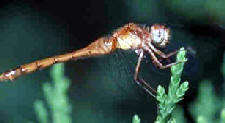 Big Red Skimmer Big Red Skimmer
Family Libellulidae
(Skimmers)
Libellula saturata
NATIVE
Large (52-61 mm with a body and basal half of winds with
bright rust color. Adults are common along the pond
margins. |
DAMSELFLIES (Zygoptera)
Damselflies are very similar to dragonflies except they
are
generally smaller and more fragile. When they perch
their wings are closed. |
 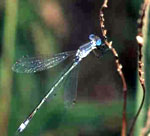 California Dancer California Dancer
Order
Odontata
Argia agrioides
NATIVE
The male is
mainly blue on its abdomen, except for a black segment
toward the rear. The black stripe on each of the thorax
is forked. The young male is brown, and the female may
be tan and black or blue and black. Length is 3-3.5 cm
with a wing span 3.5 – 4.25 cm. |
|
ORDER LEPIDOPTERA
BUTTERFLIES
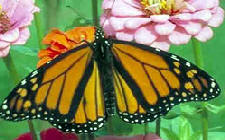 Monarch Monarch
Family Nymphalidae
(brush-footed)
anaus plexippus
NATIVE
Monarchs winter along the California coast and breed in
areas west of the Rockies. This butterfly is famous
for its long migrations. In fall you can find them in
several locations such as Ardenwood in Fremont where
they may congregate until spring. The sex of monarchs
can only be determined by dissection. |
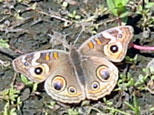 Buckeye Buckeye
Family Nymphalidae
(brush-footed)
Junonia coenia
NATIVE
Their multicolored “eyespots” help to distract
predators. Wing span ranges from 3.5-5.2 cm with brown
wings marked on the upper sides by a large and small eye
spot on each wing. The larva is dark with longitudinal
pale yellow stripes and branching spines and feeds on
plantain. |
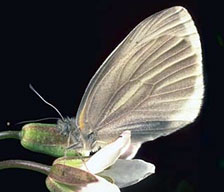 Cabbage White Cabbage White
Family Pieridae (whites
and sulfurs)
Pieris rapae
NATIVE
A
very common butterfly that was introduced from Europe in
1866. When mature, has a pale yellow line on the back,
and a line formed of yellow spots on each side. It
normally sits on the upper surfaces of leaves of its
food plant in broad daylight. Its coloration is
presumably an effective camouflage. It grows to a length
of about 3 cms. |
|
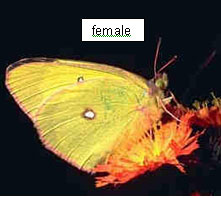 California Dogface California Dogface
Family Pieridae (whites and sulfurs)
Zerene eurydice
NATIVE
This is the
California’s official state butterfly, designated in
1972/Wing span about 5.1 - 6.3 cm. Black outer half of
male forewing encloses yellow-orange "dog's head" tinged
with light purple iridescence. Black "eye" very near or
touching the border. Hind wing yellow-orange, sometimes
with black border. Female all yellow with a black upper
forewing cell spot; sometimes with scattered black
scaling on outer half. Larva is dull green with a white
lateral line that feeds on False Indigo (Amorpha
californica). |
|
|